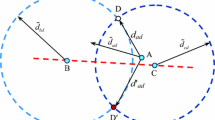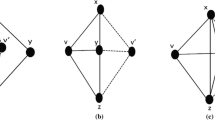Abstract
Collinear or near collinear placement of some sensors in a wireless sensor network causes the location estimates of nearby sensors to be sensitive to erroneous distance measurements which leads to large location estimation errors. These errors and the possible propagation of these errors to the entire network or a large portion of it, thereby causing larger estimation errors for some sensors’ locations, is a major problem in localization. This phenomenon is well described in rigid graph theory, using the notion of “flip ambiguity”. This paper considers arbitrary sensor neighborhoods of two dimensional sensor networks and formulates an analytical expression for the probability of occurrence of the flip ambiguity. Based on the derived probability expression, a methodology is proposed to make the localization algorithms robust by calculating such flip ambiguity probabilities and eliminating potentially poor location estimates as well as assigning confidence factors to the estimated locations to prevent them from ruining the subsequent localization steps. The efficiency of the proposed methodology is demonstrated via a set of simulations.










Similar content being viewed by others
References
Eren, T., Goldenberg, D., Whiteley, W., Yang, Y., Morse, A., Anderson, B., & Belhuneur, P. (2004). Rigidity, computation, and randomization in network localisation. In IEEE INFOCOM, Vol. 4, pp. 2673–2684.
Goldenberg, D., Krishnamurthy, A., Maness, W., Yang, Y., & Young, A. (2005). Network localization in partially localizable networks. In IEEE INFOCOM, pp. 313–326.
Hendrickson, B. (1992). Conditions for unique graph realizations. SIAM Journal of Computation, 21(1), 65–84.
Moore, D., Leonard, J., Rus, D., & Teller, S. (2004). Robust distributed network localization with noisy range measurements. In 2nd ACM conf. on embedded networked sensor systems, pp. 50–61.
Mao, G., Fidan, B., & Anderson, B. (2007). Wireless sensor network localization techniques. Computer Networks, 51(10), 2529–2553.
Kannan, A. A., Fidan, B., & Mao, G. (2008). Robust distributed sensor network localization based on analysis of flip ambiguities. In IEEE GlobeCom, pp. 1–6.
Niculescu, D., Nath, B. (2003). Dv based positioning in ad hoc networks. Telecommunication Systems, 22(1–4), 267–280.
Savvides, A., Han, C. C., & Srivastava, M. B. (2001). Dynamic fine-grained localization in ad-hoc networks of sensors. In ACM SigMobile, pp. 166–179.
Savarese, C., & Rabaey, J. (2002). Robust positioning algorithms for distributed ad-hoc wireless sensor networks. In Proceedings of the general track: 2002 USENIX annual technical conference, pp. 317–327.
Savarese, C., Rabaey, J., & Beutel, J. (2001). Locationing in distributed ad-hoc wireless sensor networks. In ICASSP, pp. 2037–2040.
Meertens, L., & Fitzpatrick, S. (2004). The distributed construction of a global coordinate system in a network of static computational nodes rom inter-node distances. Kestrel Institute, formal report KES.U.04.04.
Capkun, S., Hamdi, M., & Hubaux, J. (2001). Gps-free positioning in mobile ad-hoc networks. In 34th Hawaii international conference on system sciences, pp. 3481–3490.
Ji, X., & Zha, H. (2004). Sensor positioning in wireless ad-hoc sensor networks using multidimensional scaling. In IEEE INFOCOM, Vol. 4, pp. 2652–2661.
Kwon, Y., Mechitov, K., Sundresh, S., Kim, W., & Agha, G. (2005). Resilient localization for sensor networks in outdoor environments. In IEEE ICDCS, pp. 643–652.
Kannan, A., Mao, G., & Vucetic, B. (2006). Simulated annealing based wireless sensor network localization with flip ambiguity mitigation. In IEEE vehicular technology conference, Vol. 2, pp. 1022–1026.
Kannan, A. A., Fidan, B., & Mao, G. (2010). Analysis of flip ambiguities for robust sensor network localization. In IEEE transactions on vehicular technology, Vol 59, No. 4, pp. 2057–2070.
Ihler, A. T., Fisher III, J. W., Moses, R. L., & Willsky, A. S. (2005). Nonparametric belief propagation for self-localization of sensor networks. In IEEE Journal on Selected Areas in Communications, Vol. 23, pp. 809–819.
Lederer, S., Wang, Y., & Gao, J. (2008). Connectivity-based localization of large scale sensor networks with complex shape. In IEEE INFOCOM, pp. 789–797.
Fang, J., Cao, M., Morse, A., & Anderson, B. (2006). Localization of sensor networks using sweeps. In IEEE conference on decision and control, pp. 4645–4650.
Wang, Y., Lederer, S., & Gao, J. (2009). Connectivity-based sensor network localization with incremental delaunay refinement method. In IEEE INFOCOM, pp. 2401–2409.
Yang, Z., Liu, Y., & Li, X. (2009). Beyond trilateration: On the localizability of wireless ad-hoc networks. In IEEE INFOCOM, pp. 2392—2400.
Sittile, F., & Spirito, M. (2008). Robust localization for wireless sensor networks. In IEEE SECON, pp. 46–54.
Kannan, A., Fidan, B., Mao, G., & Anderson, B. (2007). Analysis of flip ambiguities in distributed network localization. In Information, decision and control, pp. 193–198.
Goldenberg, D., Bihler, P., Cao, M., Fang, J., Anderson, B., Morse, A., & Yang, Y. (2006). Localization in sparse networks using sweeps. In ACM/IEEE MobiCom, pp. 110–121.
Patwari, N., Hero III, A., Perkins, M., Neiyer, S., & O’Dea, R. (2003). Relative location estimation in wireless sensor networks. IEEE Transactions on Signal Processing, 51(8), 2137–2148.
Kannan, A., Fidan, B., & Mao, G. Implementation of the generic equation (25) on the journal paper Use of Flip Ambiguity Probabilities in Robust Sensor Network Localization. http://www.ee.usyd.edu.au/people/guoqiang.mao/UserFiles/File/Kannan11Use-MatlabCode.pdf.
Acknowledgments
The work was supported by National ICT Australia-NICTA. NICTA is funded by the Australian Government as represented by the Department of Broadband, Communications and the Digital Economy and the Australian Research Council through the ICT Centre of Excellence program.
Author information
Authors and Affiliations
Corresponding author
Appendices
A Calculation of \(P(\zeta_{AB}\mid p(A),p(B),p(C),p(D))\)
Denote by H C the open half plane containing the sensor s C , bordered by the line AB as shown in Fig. 11, then the complementary half plane on the other side of line AB can be denoted by \(H_{\overline{C}}\). For a non-collinear neighborhood N D = {s A , s B , s C }, H C and \(H_{\overline{C}}\) are well defined. Denote by p AB C (D) and \(p_{\overline{C}}^{AB}(D)\) the intersection points of the two circles \({{\mathcal{C}}(p(A),\overline{d}_{AD})}\) and \({{\mathcal{C}}(p(B),\overline{d}_{BD})}\). Without loss of generality, let \(p_C^{AB}(D) \in H_C\), which will leave the other intersection point \(p_{\overline{C}}^{AB}(D)\in H_{\overline{C}}\) as shown in Fig. 11.
When considering distance measurements from only two neighboring sensors s A and s B , both points p AB C (D) and \(p_{\overline{C}}^{AB}(D)\) are possible candidates for the location estimate \(\hat{p}(D)\) of sensor s D with \((\|p(A)-\hat{p}(D)\|-\overline{d}_{AD})^2+(\|p(B)-\hat{p}(D)\|-\overline{d}_{BD})^2=0\). When the third distance measurement from the neighboring sensor s C is included in the localization process, a new candidate for the location estimate \(\hat{p}(D)\) considering the third distance measurement \(\overline{d}_{CD}\) is obtained as
where the cost function \(J(\hat{p}^*(D))\) is defined as
Proposition A.1
With non-collinear neighbors s A , s B , s C , the location estimate \(\hat{p}(D)\) satisfies the following:
-
i
\(\hat{p}(D) \in H_C \quad if\; 0\le\overline{d}_{CD}< \lambda_C-2\overline{\epsilon}\)
-
ii
\(\hat{p}(D) \in H_{\overline{C}} if\; \lambda_C+2\overline{\epsilon} <\overline{d}_{CD}\le R+\overline{\epsilon}\)
where \(\lambda_C=\frac{\|p(C)-p_C^{AB}(D)\|+\|p(C)-p_{\overline{C}}^{AB}(D) \|}{2}\).
Proof
Because of Assumption 2, we have (i) \(D\in R_D^{AB}=R_{D_1}^{AB}\cup R_{D_2}^{AB}\) and (ii) D lies in the annulus with center C and radii \(\overline{d}_{CD}\pm \overline{\epsilon}\). Denote the intersection regions of this annulus with R AB D ∩ H C and \(R_D^{AB}\cap H_{\overline{C}}\) by S C_1 and \(S_{\overline{C}_1}\) respectively; and the reflections of S C_1 and \(S_{\overline{C}_1}\) with respect to AB by \(S_{\overline{C}_2}\) and S C_2 respectively. Let S C = S C_1 ∪ S C_2 and \(S_{\overline{C}}=S_{\overline{C}_1} \cup S_{\overline{C}_2}\). Note that \(S_C \subset R_D^{AB} \cap H_C\) and \(S_{\overline{C}} \subset R_D^{AB} \cap H_{\overline{C}}\) and that neither S C nor \(S_{\overline{C}}\) is empty set since each of them contains either D or the reflection of D with respect to AB. The value of \(\hat{p}^*(D)\) minimizing (A.1) lies in either S C or \(S_{\overline{C}}\) since (i) at least one of the three quadratic components of \(J(\hat{p}^*(D))\) is larger than \(\overline{\epsilon}^2\) and hence \(J(\hat{p}^*(D))>\overline{\epsilon}^2\) outside \(S_C \cup S_{\overline{C}}\) and (ii) \(S_C \cup S_{\overline{C}}\) contains points \(\hat{p}^*(D)\) at which \(J(\hat{p}^*(D))\le \overline{\epsilon}^2\) (the intersection points of the circles \({{\mathcal{C}}(A,\overline{d}_{AD}), {\mathcal{C}}(B,\overline{d}_{BD}), {\mathcal{C}}(C,\overline{d}_{CD})}\)). □
First consider the case \(0\le \overline{d}_{CD} < \lambda_C -2\overline{\epsilon}\). Noting that \(\left\| p(C)-p_C^{AB}(D)\right\| < \lambda_C < \left\| p(C)-p_{\overline{C}}^{AB}(D) \right\|\) and analyzing all possible values of \(\overline{d}_{CD} < \lambda_C - 2\overline{\epsilon}\), it can be established that
For each point \(\hat{p}^*(D)\in S_{\overline{C}}\), the reflection \(\hat{p}_2^*(D)\in S_C\) of \(\hat{p}^*(D)\) with respect to AB satisfies
Hence we have
Furthermore, since \(\hat{p}^*(D)\in S_{\overline{C}} \subset R_D^{AB} \cap H_{\overline{C}}\) and \(\hat{p}_2^*(D)\in S_C \subset R_D^{AB} \cap H_C\), we have
which, respectively imply
Combining (36), (37) with (38) we obtain
(35) and (38) imply that \(\hat{p}(D)\) cannot be in \(H_{\overline{C}}\), i.e. \(\hat{p}(D)\in H_C\).
The case \(\lambda_C + 2\overline{\epsilon} < \overline{d}_{CD} \le R+\overline{\epsilon}\) can be analysed similarly to obtain that in this case \(\hat{p}(D) \in H_{\overline{C}}\). This completes the proof of Proposition A.1.
In (14), it is defined that \(p(D)\in R_{D_1}^{AB}\) and, thus, a flipped realization occurs when
-
i
\(\hat{p}(D) \in H_C \quad and\; R_{D_1}^{AB} \subset H_{\overline{C}} \)
-
ii
\(\hat{p}(D) \in H_{\overline{C}}\quad and\;R_{D_1}^{AB} \subset H_C\)
With this information, two support spaces can be defined for the events defined in (16) and (17) as:
Using Proposition A.1 and assuming that \(\overline{\epsilon}\) is sufficiently small, (40) can be approximated by
The measured distances \(\overline{d}_{AD}, \overline{d}_{BD}\) and \(\overline{d}_{CD}\) are respectively the true distances \(\|p(A)-p(D)\|, \|p(B)-p(D)\|\) and \(\|p(C)-p(D)\|\) blurred by additive Gaussian measurement errors \({{\mathcal{N}}(0,\sigma^2)}\) as in (1). Thus, the probability density functions \(f(\overline{d}_{AD}\mid p(A),p(B),p(C),p(D)), f(\overline{d}_{BD}\mid p(A),p(B),p(C),p(D))\) and \(f(\overline{d}_{CD}\mid p(A),p(B),p(C),p(D))\) of the measured distances \(\overline{d}_{AD}, \overline{d}_{BD}\) and \(\overline{d}_{CD}\) can be written as
and are independent of each other. In order to keep the equations simple, the probability density functions are re-named as follows:
Due to the independent nature of the probability density functions \(\overline{f}(\overline{d}_{AD}), \overline{f}(\overline{d}_{BD})\) and \(\overline{f}(\overline{d}_{CD})\), define two binary functions δ CD and I CD as
which let the probability \(P(\zeta_{AB}\mid p(A),p(B),p(C),p(D))\) to be expressed as
B Calculation of A S
The neighbor geometry p(A)p(B)p(C) and the transmission range R determines the area A S where the sensor s D could be placed. The possible neighbor geometry p(A)p(B)p(C) could be divided into two groups as shown in Fig. 12. The following calculation of A S considered the neighbor geometries p(A)p(B)p(C) in the group \(\|p(C)-P_1\|<R\). The same argument can be applied to the neighbor geometries p(A)p(B)p(C) in the other group \(\|p(C)-P_1\|\ge R\). The area A S for placement of sensor s D can be divided into three circle segments and a triangle as illustrated in the Fig. 12(a) and calculated as
-
(i)
$$ \begin{aligned} A_1 &= \hbox{area of segment}\, P_1Q_1 \\ &= R^2 \sin^{-1}\frac{\|P_1-Q_1\|}{2R}-\frac{R^2} {2}\sin\left(2\sin^{-1}\frac{\|P_1-Q_1\|}{2R}\right) \end{aligned} $$
-
(ii)
$$ \begin{aligned} A_2 &= \hbox{area of segment}\, Q_1R_1 \\ &= R^2 \sin^{-1}\frac{\|Q_1-R_1\|}{2R}-\frac{R^2} {2}\sin\left(2\sin^{-1}\frac{\|Q_1-R_1\|}{2R}\right) \end{aligned} $$
-
(iii)
$$ \begin{aligned} A_3 &= \hbox{area of segment}\, P_1R_1 \\ &= R^2 \sin^{-1}\frac{\|P_1-R_1\|}{2R}-\frac{R^2} {2}\sin\left(2\sin^{-1}\frac{\|P_1-R_1\|}{2R}\right) \end{aligned} $$
-
(iv)
$$ \begin{aligned} A_4 &= \hbox{area of}\, \triangle P_1Q_1R_1\\ &= \sqrt{s(s-\|P_1-Q_1\|)(s-\|Q_1-R_1\|)(s-\|P_1-R_1\|)} \end{aligned} $$
where \(s=\frac{\|P_1-Q_1\|+\|Q_1-R_1\|+\|P_1-R_1\|}{2}\)
Thus the possible area for placement of D
Rights and permissions
About this article
Cite this article
Kannan, A.A., Fidan, B. & Mao, G. Use of flip ambiguity probabilities in robust sensor network localization. Wireless Netw 17, 1157–1171 (2011). https://doi.org/10.1007/s11276-011-0333-z
Published:
Issue Date:
DOI: https://doi.org/10.1007/s11276-011-0333-z






